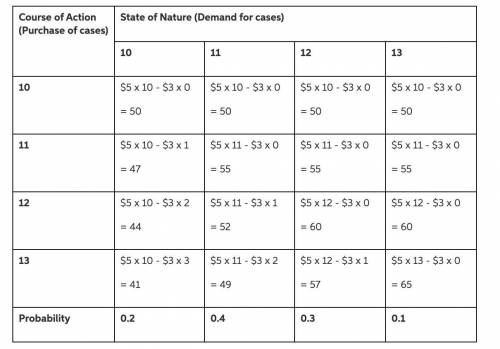
Business, 22.02.2020 03:15 Mikkixo3114
Jean Clark is the manager of the Midtown Safeway Grocery Store. She now needs to replenish her supply of strawberries. Her regular supplier can provide as many cases as she wants. However, because these strawberries already are very ripe, she will need to sell them tomorrow and then discard any that remain unsold. Jean estimates that she will be able to sell 10, 11, 12, or 13 cases tomorrow. She can purchase the strawberries for $3 per case and sell them for $8 per case. Jean now needs to decide how many cases to purchase.
Jean has checked the store’s records on daily sales of strawberries. On this basis, she estimates that the prior probabilities are 0.2, 0.4, 0.3, and 0.1 for being able to sell 10, 11, 12, and 13 cases of strawberries tomorrow.
1. What are decision variables and what are the states of nature in this problem?
2. Draw and upload the payoff table for this problem. (NOTE: You can draw the table either using software (e. g., Microsoft Paint, PowerPoint) or on a piece of paper and take a picture.)
3. If Jean wants to follow the maximin criterion, what should she do and why?
4. How many cases should Jean order if she follows the maximum likelihood criterion? Why?
5. How many cases should Jean order if she follows Bayes' decision rule and why?
6. What's the most Jean should be willing to spend to get more information about how many cases of strawberries she might be able to sell tomorrow?

Answers: 3


Another question on Business

Business, 21.06.2019 19:50
Suppose your rich uncle gave you $50,000, which you plan to use for graduate school. you will make the investment now, you expect to earn an annual return of 6%, and you will make 4 equal annual withdrawals, beginning 1 year from today. under these conditions, how large would each withdrawal be so there would be no funds remaining in the account after the 4th?
Answers: 1

Business, 22.06.2019 07:40
Xyz corporation has provided the following data concerning manufacturing overhead for july: actual manufacturing overhead incurred $ 69,000 manufacturing overhead applied to work in process $ 79,000 the company's cost of goods sold was $243,000 prior to closing out its manufacturing overhead account. the company closes out its manufacturing overhead account to cost of goods sold. which of the following statements is true? multiple choice manufacturing overhead was overapplied by $10,000; cost of goods sold after closing out the manufacturing overhead account is $253,000 manufacturing overhead was underapplied by $10,000; cost of goods sold after closing out the manufacturing overhead account is $233,000 manufacturing overhead was underapplied by $10,000; cost of goods sold after closing out the manufacturing overhead account is $253,000 manufacturing overhead was overapplied by $10,000; cost of goods sold after closing out the manufacturing overhead account is $233,000
Answers: 1

Business, 22.06.2019 08:10
Exercise 15-7 crawford corporation incurred the following transactions. 1. purchased raw materials on account $53,000. 2. raw materials of $45,200 were requisitioned to the factory. an analysis of the materials requisition slips indicated that $9,400 was classified as indirect materials. 3. factory labor costs incurred were $65,400, of which $50,200 pertained to factory wages payable and $15,200 pertained to employer payroll taxes payable. 4. time tickets indicated that $55,000 was direct labor and $10,400 was indirect labor. 5. manufacturing overhead costs incurred on account were $81,700. 6. depreciation on the company’s office building was $8,100. 7. manufacturing overhead was applied at the rate of 160% of direct labor cost. 8. goods costing $89,400 were completed and transferred to finished goods. 9. finished goods costing $76,000 to manufacture were sold on account for $105,100. journalize the transactions. (credit account titles are automatically indented when amount is entered. do not indent manually.) no. account titles and explanation debit credit (1) (2) (3) (4) (5) (6) (7) (8) (9) (to record the sale) (to record the cost of the sale) click if you would like to show work for this question: open show work
Answers: 1

Business, 22.06.2019 19:30
Which of the following businesses is most likely to disrupt an existing industry? a. closer connex developed an earphone that receives emails and text messages and converts them to voice messages. the first models had poor reception, but they rapidly improved over time. b. mega technologies reconfigured the components used in its touchscreen tablets to create a new type of wearable device for use in restaurants and other service industries. c. particle inc. developed a teleportation technology that can transport physical materials instantaneously across great distances. d. altrea added advanced camera technology to its premium line of smartphones so that they would take the highest-quality photos of all phones on the market.
Answers: 1
You know the right answer?
Jean Clark is the manager of the Midtown Safeway Grocery Store. She now needs to replenish her suppl...
Questions


History, 07.10.2019 01:30

English, 07.10.2019 01:30


History, 07.10.2019 01:30

Biology, 07.10.2019 01:30

History, 07.10.2019 01:30




Geography, 07.10.2019 01:30



Social Studies, 07.10.2019 01:30

History, 07.10.2019 01:30

Mathematics, 07.10.2019 01:30

Mathematics, 07.10.2019 01:30

Mathematics, 07.10.2019 01:30

Mathematics, 07.10.2019 01:30








